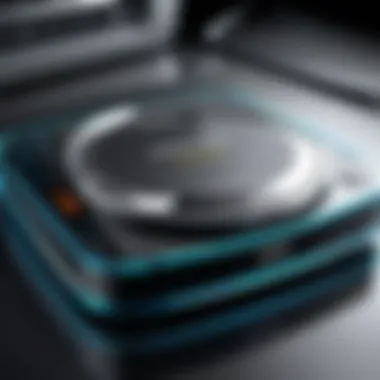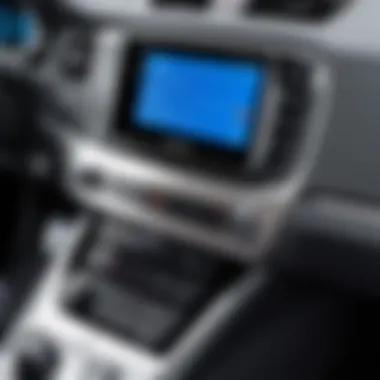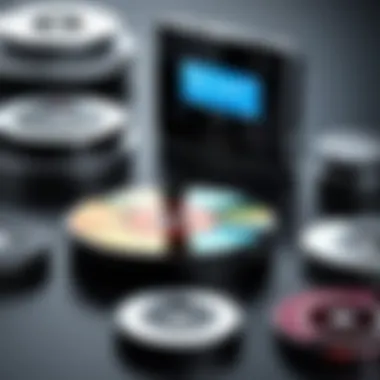The Comprehensive Guide to Portable CD Players for Cars


Intro
In an era where digital streaming dominates music consumption, portable CD players may seem like an outdated technology. However, they still offer dedicated audio enthusiasts a way to enjoy physical music collections, particularly in car environments where streaming services may face connectivity issues. This comprehensive guide aims to explore portable CD players with USB output designed for automotive use, shedding light on their functionality, advantages, and potential drawbacks. By delving into various facets of these devices, we will provide insights that cater to both tech enthusiasts and casual users looking to reintegrate their cherished CDs into modern car audio systems.
Product Overview
Brief Description
Portable CD players with USB output enable users to play their audio CDs while in their vehicles. The added USB feature allows for broader compatibility, as users can either connect the device to a car stereo via a USB port or utilize it to play media from a USB flash drive. This dual functionality grants users greater flexibility in enjoying their music.
Key Features
- USB Connectivity: Enables easy connection to car stereos with USB ports.
- Compact Design: Lightweight and designed for portability, making it easy to transport.
- Multi-Format Compatibility: Capable of playing various disc formats, including CD-R and CD-RW.
- Audio Quality: Typically maintains high-quality sound output, appealing to audiophiles.
- Battery Life: Many models offer long-lasting battery performance, suitable for extended road trips.
Available Variants
- Dedicated CD Players: Focus on CD playback with basic USB functionality.
- Multimedia Players: Offer additional features like Bluetooth support and FM radio.
- High-Resolution Audio Models: Designed for audiophiles, often featuring enhanced sound processing capabilities.
Specifications Breakdown
Technical Specifications
- Audio Formats Supported: CD, CD-R, CD-RW.
- USB Support: USB 2.0 or 3.0 compatibility.
- Battery Type: Typically rechargeable Lithium-ion or AAA batteries.
- Output Power: Varies by model, often around 1W to 5W.
Performance Metrics
- Sound Quality: Depends on the DAC and amplification used in each player.
- Battery Life: Average ranges from 8 to 20 hours, depending on usage.
- Loading Time: Generally under 10 seconds for most units, but can vary.
Compatibility Information
- Car Stereo Types: Compatible with most vehicles that offer a USB port for audio input.
- Peripheral Devices: Can often connect to headphones or speaker systems via standard audio jacks.
Comparative Analysis
Competing Products
- Sony Walkman D-NE20: Known for durability and sound quality.
- Phillips AZ787/37: Offers multiple playback choices including MP3 CD support.
- BOSS Audio Systems BCD990: Combines CD playback with Bluetooth functionality.
Strengths and Weaknesses
- Strengths:
- Weaknesses:
- Excellent sound reproduction.
- Versatility in playback options.
- Often includes anti-skip technology for smoother playback during driving.
- Bulkier compared to modern music solutions.
- Limited by battery life in certain models.
Price Comparison
- Lower End Models: Range from $30 to $50.
- Mid-Range Options: Typically between $50 and $100.
- High-End Models: Can exceed $100, with additional features and premium sound quality.
Buying Guide
Target User Profiles
- Audiophiles: Individuals seeking high-quality sound and performance.
- Casual Listeners: Users who prefer physical media and value simplicity.
- Travel Enthusiasts: Those who frequently drive long distances and wish to enjoy their music collections.
Important Considerations
- Connectivity: Ensure compatibility with car stereo systems.
- Durability: Look for units designed to withstand travel.
- Ease of Use: Consider user interface and controls for convenience.
Insider Tips for Buyers
- Check for user reviews to gauge reliability.
- Assess battery life claims based on personal usage scenarios.
- Take note of warranty information for added security.
Maintenance and Upgrade Insights
Regular Maintenance Practices
- Cleaning: Regularly clean the lens and discs to prevent playback issues.
- Battery Care: Maintain battery health by avoiding frequent deep discharges.
Upgrade Paths and Options
- Consider models with Bluetooth support for more functionality.
- Look for firmware updates to improve performance.
Troubleshooting Common Issues


- Playback Jitter: Ensure disc is clean and free of scratches.
- Power Issues: Check cable connections and battery status.
Investing in a quality portable CD player with USB output can breathe new life into your music experience while on the road. Ensuring you understand the specifications, features, and maintenance requirements can enhance your overall satisfaction with the device.
By offering a detailed examination of these players' essential aspects, this guide equips readers with the knowledge needed to make an informed choice.
Preface to Portable Players
In an age where digital streaming and mp3 formats reign supreme, the relevance of portable CD players may seem diminished. However, these devices still hold significant value, especially for those who appreciate the tactile experience of physical media and the robust sound quality that CDs can provide. Understanding portable CD players involves recognizing their unique advantages, including versatility, ease of use and the nostalgic connection to music. For many, owning a portable CD player with USB output is not just about playback; it’s about forming a deeper bond with music while on the go.
Understanding Portable Playback
Portable CD players allow users to enjoy music in a format that many regard as superior to compressed files. The fidelity offered by CDs highlights the nuances in sound, giving listeners an immersive audio experience. These players are designed for various applications, from casual listening to professional use. By integrating features like anti-skip protection and quick access controls, modern portable CD players enhance usability, especially during travel.
Users should understand the basic functionalities of these devices. Most players offer straightforward control schemes, featuring buttons like play, pause, skip, and track selection. Some models even incorporate advanced features such as resume playback, allowing users to continue from where they left off. Additionally, many portable devices come equipped with a headphone jack and built-in speakers, adding to the listening versatility.
The Role of USB Output in Connectivity
USB output serves an essential role for portable CD players, elevating their utility in contemporary settings. This functionality allows users to connect their CD players not only to their car audio systems but also to various devices, such as computers and external power sources. Through USB connections, the transfer of data and power become seamless, enabling users to charge their devices while enjoying their favorite albums.
The integration of USB output makes these players compatible with modern technical standards, offering a bridge between traditional physical media and modern digital formats. With USB, users can explore new ways to engage with their music, whether playing CDs through a car audio system or transferring tracks to digital libraries. As such, portable CD players with USB output represent a blend of nostalgia and modern convenience, catering to consumers who wish to enjoy the richness of CDs without compromising on connectivity.
Key Features of Portable Players with USB Output
Portable CD players equipped with USB output have gained recognition, especially among automotive users. The significance of understanding their key features cannot be understated, as it directly relates to both user experience and technological compatibility. This section will break down essential aspects that define these players, highlighting the benefits and considerations that may guide potential buyers towards making informed choices.
Audio Quality Considerations
Audio quality is paramount for any music playback device, and portable CD players with USB output are no exception. These players should ideally support various audio formats to enhance listening experiences. Formats like MP3 and WAV can be played through USB, enabling a broader range of options.
It is vital to consider the DAC (Digital-to-Analog Converter) used in the device. High-quality DACs can significantly improve sound reproduction, allowing for clearer highs and richer lows. Furthermore, some models offer features like digital signal processing (DSP), which can further enhance audio fidelity.
When evaluating audio quality, take into consideration the maximum bitrate supported by the player. Higher bitrates translate to better sound quality, which is especially crucial for audiophiles. Additionally, reading user reviews can provide insight into real-world performance versus specifications.
Design and Portability Factors
Design is more than just aesthetics; it plays a critical role in the functionality of portable CD players. A compact and lightweight design is essential for easy transport. Users often desire players that can fit in glove compartments or backpack pockets without sacrificing durability.
Materials used in construction also matter. Look for players with robust outer casings that can withstand typical wear and tear encountered during travel. Some models feature anti-shock technology, mitigating the impact of movement on audio playback.
Moreover, designs that include user-friendly controls can enhance the experience. Intuitive buttons or touch controls can make navigating playlists easier while driving. LCD screens that display track information and battery levels are another desirable feature that promotes usability.
Battery Life and Power Management
Battery life is a critical factor, especially for users who may not want to rely on constant external power sources. Most portable CD players with USB output operate on rechargeable batteries, and their longevity directly impacts user convenience.
Models with extended playtime can be more advantageous, allowing users to enjoy music during long drives without the need for frequent recharging. Some players include power management features that automatically go into standby mode when not in use, prolonging overall battery life.
When considering power management, check for indicators that show battery status. An easy-to-read display can help prevent sudden shutdowns during use.
In summary, understanding the key features of portable CD players with USB output is crucial for making an informed choice. Users should pay attention to audio quality, design, portability, battery life, and power management capabilities for an optimal experience.
Advantages of Using Portable Players in Vehicles
Portable CD players with USB output play a significant role in enhancing the in-car audio experience. Their contribution extends beyond mere music playback, tapping into the desires of drivers who value both nostalgia and convenience. In this section, we will explore two main advantages of these devices, focusing on their unique elements that make them compelling choices for users who appreciate physical media and compatibility with existing systems.
Convenience of Physical Media
In an increasingly digital world, many tech enthusiasts still hold a fondness for physical media. The tactile experience of holding a CD signifies a connection to the music, different from streaming or digital downloads. A portable CD player allows users to enjoy their favorite albums in their original format, without the need of an internet connection or battery-draining devices.
Furthermore, CDs often contain bonus tracks, detailed liner notes, or artwork that enhance the listening experience. For automobile environments, the presence of a portable CD player means that users can quickly access their beloved collections without fumbling around with screens or playlists. This aspect proves especially valuable on long trips, where familiarity becomes comforting amid travel uncertainties.
"Physical media maintains a cult following among true music enthusiasts who seek something beyond mere songs."
Yet, convenience also implies ease of use. Most portable CD players with USB features come equipped with straightforward controls, making them relatively user-friendly. Plugging into the car's USB port allows for a seamless integration, even for those who may not be tech-savvy. With the press of a button, music plays, requiring minimal effort, which is crucial when operating a vehicle.
Compatibility with Existing Fujiteles
The term Fujiteles may refer to various legacy audio systems that one may encounter in older cars. Portable CD players with USB outputs are designed to offer compatibility with these systems, catering to drivers who might not have invested in modern audio solutions.
These players can bridge the gap between outdated and modern technologies. For instance, many vehicles were manufactured before Bluetooth or Wi-Fi streaming capabilities were common. A portable CD player provides a viable solution, enabling users to enjoy their CDs while still taking advantage of USB interfaces. This functionality broadens the reach of music enjoyment, allowing those who possess classic car models to modernize their experiences without major overhauls to their audio systems.
Key advantages of compatibility include:
- Easy Setup: Users can often plug and play without complex configurations.
- Versatility: They can read a variety of formats, accommodating different audio needs.
- Consistency: Users enjoy a reliable source of music, unaffected by signal interruptions that often plague streaming solutions.


Limitations of Portable Players
Discussing the limitations of portable CD players is essential in understanding their role in today’s automotive audio landscape. While they provide a nostalgic connection to physical media, several factors complicate their relevance and functionality. This analysis will delve into two primary limitations: the declining popularity of CD formats and potential technical issues that may arise with these devices.
Declining Popularity of Formats
The popularity of CD formats has been on the downward slope for years. Streaming services like Spotify and Apple Music dominate the audio landscape, making physical media less appealing to consumers. Many people have shifted to digital downloads, which offer more convenience and access to a wider selection of music. This evolution means that portable CD players face fierce competition from modern solutions that integrate Bluetooth, Wi-Fi, and online streaming capabilities.
As such, car manufacturers often prioritize systems that support these trends instead of investing in CD drives or making vehicles compatible with portable CD players. Consequently, the overall market for portable CD players has shrunk dramatically, limiting both innovation and availability. Users might find new models increasingly hard to come by, and their features may not meet the expectations of more tech-savvy consumers who favor seamless integration with their devices.
Moreover, the ongoing shift away from CDs means that manufacturers are less likely to focus on making portable CD players a priority in their product lines. For instance, even dedicated audio brands have begun to reduce the variety of CD players they produce, which affects consumer choices. Without a compelling reason to purchase, many potential buyers opt for more current technology, such as smartphones that can stream audio.
Potential Technical Issues
Beyond declining popularity, portable CD players can experience various technical issues that may hinder performance. These concerns can arise from the design and build quality of the player itself, which may not withstand the rigors of daily use in a moving vehicle. Some common problems include skipping of tracks, poor read times, and battery malfunction.
- Skipping of Tracks: When a car hits a bump or travels over uneven terrain, the portable CD player may struggle to maintain consistent playback. This can lead to frustrating interruptions in the listening experience.
- Poor Read Times: The time it takes for the player to recognize a CD can vary greatly. In some instances, this delay can be significant, causing frustration and affecting the overall user experience.
- Battery Malfunction: Many portable CD players operate on batteries. Over time, these batteries can lose their charge capacity, making it necessary to replace them more frequently than users might expect.
"Potential issues such as skipping tracks and poor battery life can significantly impact the enjoyment of portable CD players in vehicles."
It is also worth noting that compatibility issues can arise with various car models. Not all vehicles are equipped with Bluetooth or AUX inputs, which limits how easily users can connect their portable CD players. These practical issues may deter users from investing in a portable CD player and drive them towards more integrated audio solutions.
In summary, while portable CD players do serve a niche audience, the trends in consumer preferences and the technical challenges they face cast a shadow on their future in automotive contexts.
Comparison with Alternative Audio Solutions
In the evolving landscape of automotive audio, evaluating portable CD players with USB output necessitates understanding how they measure against other popular audio solutions. The demand for diverse listening experiences has led to the rise of alternative options like Bluetooth and streaming devices, as well as integrated car audio systems. Analyzing these alternatives provides valuable insights to buyers.
Bluetooth and Streaming Devices
Bluetooth and streaming devices have gained immense popularity in recent years. Many users prefer these systems due to their convenience and the growing library of music available on platforms like Spotify and Apple Music. Unlike CD players, which require physical media, Bluetooth provides seamless access to digital libraries. This shift allows greater flexibility, letting users curate playlists and enjoy new content without needing to purchase separate discs. Furthermore, Bluetooth technology has become integral in many modern cars, making it a compelling option for audio consumption.
Another factor to consider is the quality of sound. Bluetooth technology has improved significantly, offering high-fidelity audio, although slight compression can occur. For audiophiles, this might be a drawback, yet many users find the trade-off acceptable given the ease of use.
Integrated Car Audio Systems
Integrated car audio systems represent another alternative worth discussing. These systems are often pre-installed in vehicles and provide a comprehensive audio experience with no need for additional devices. Typically, they support various formats, including CDs, USB drives, and Bluetooth connectivity. This versatility enables users to enjoy their favorite music without the hassle of balancing multiple components.
When comparing integrated systems to portable CD players, it is essential to consider installation and warranty aspects. Integrated systems are designed specifically for the vehicle, which means that they often come with warranties that cover any potential malfunctions. In contrast, portable CD players may not fit securely or may require additional adapters to work correctly with an existing car audio setup.
Moreover, integrated systems can potentially yield a superior audio experience. With advanced sound technology and built-in equalizers, these systems can enhance audio quality beyond what portable alternatives can offer. Consider the following:
- Convenience: Less clutter and no need for additional setup.
- Quality: Enhanced sound due to optimal integration.
- User Interface: More straightforward and easier to use while driving.
In summary, both Bluetooth and streaming devices, along with integrated car audio systems, present viable alternatives to portable CD players with USB output. Each option has its advantages, making it crucial for consumers to assess their priorities, whether that be sound quality, ease of use, or versatility in audio sources.
What to Consider When Buying a Portable Player with USB Output
When it comes to selecting a portable CD player with USB output, there are several key elements to consider. The landscape of portable audio devices continues to evolve, making informed purchasing decisions crucial for maximizing your investment. This section explains important considerations that will help you navigate the various choices available in the market.
Essential Specs and Features
One of the foremost considerations is the specifications and features of the portable CD player. The audio quality should be a primary concern. Look for features like:
- Digital-to-Analog Converter (DAC): This component is critical for audio playback. A better DAC usually means improved sound quality.
- USB Compatibility: Ensure that the player supports various file formats such as MP3, WAV, and others.
- Anti-Skip Technology: This feature reduces interruptions in playback, enhancing the listening experience.
- Battery Life: A longer battery life means less time spent recharging and more time enjoying music on the go.
Each of these specifications enhances the overall usability and audio fidelity of the player, making it essential to examine them before making the final decision.
Budget Considerations
Budget is another decisive factor when purchasing a portable CD player with USB output. Prices can vary significantly between models, often influenced by features like brand reputation, build quality, and technology used. To get the best value for your money, consider the following:
- Compare Brands: Popular brands like Sony and Panasonic often offer reliable options, but lesser-known brands may provide similar quality at a lower price.
- Used vs. New: Pre-owned models can serve budget-conscious buyers well, though it is imperative to vet their condition.
- Warranty and Support: Evaluate if the model comes with a warranty. A warranty can provide peace of mind and is indicative of the manufacturer's confidence in their product.
Ultimately, determining a budget tailored to your needs and aligning it with desirable features can create a more satisfactory purchasing experience.
"Feature-rich products often prove more beneficial in the long run, so prioritizing key specifications over price can lead to better choices."
By paying attention to these considerations, you can make an informed choice that aligns with your needs, ensuring a satisfactory audio experience in your vehicle.
Maintenance and Care for Longevity
Maintaining a portable CD player with USB output is essential for ensuring its longevity and optimal performance. With regular care, these devices can provide high-quality audio for many years. This section will discuss the crucial elements of maintenance and care, as well as the benefits associated with proper handling and storage.
Cleaning and Storage Tips


Keeping your portable CD player clean is paramount. Dust, dirt, and grime can accumulate on the device over time, causing potential malfunctions. Here are some cleaning tips to follow:
- Use a soft microfiber cloth: This is ideal for wiping down the exterior of the device to avoid scratches.
- Avoid harsh chemicals: When cleaning, use only a mild cleaning solution if necessary, and ensure it does not come into direct contact with any electronic components.
- Clean the CD lens: Use a CD lens cleaner occasionally to maintain optimal sound quality. These cleaners are readily available and are easy to use.
Proper storage is equally important. Consider the following:
- Keep it in a protective case: This minimizes exposure to dust and protects against physical damage.
- Store in a cool, dry place: High temperatures and humidity can harm electronic devices. Keeping it in a stable environment is ideal.
- Avoid leaving it in a hot car: Extreme temperatures can cause irreversible damage to both the player and discs.
Troubleshooting Common Issues
Despite the best care, users may face some common issues with portable CD players. Here are ways to troubleshoot these problems:
- Disc not playing: Check if the disc is clean and free of scratches. Dirty or damaged discs can lead to playback issues.
- Skipping playback: Ensure that the device is on a flat surface. If it’s moving or shaking, the playback may skip.
- Power problems: If the device isn’t turning on, check the battery. It might need recharging or replacing. Make sure the charging cable is also functioning well.
- USB connectivity issues: If there’s trouble connecting to a computer or car sound system via USB, ensure the cable is not damaged and the port is clean.
By following these maintenance and care guidelines, users can ensure that their portable CD players remain functional and in good condition over time. Taking proactive steps is crucial to avoiding unnecessary problems and enhancing the longevity of these devices.
User Experiences and Testimonials
Understanding user experiences and testimonials is essential when discussing portable CD players with USB output. This section illuminates how everyday usage informs potential buyers about product performance, reliability, and overall satisfaction. Evaluating real-world applications provides insights that are often absent from technical specifications alone. Furthermore, hearing from actual users lends credibility to the claims made by manufacturers, allowing buyers to make informed decisions.
Real-world Applications
When considering portable CD players for vehicles, it is crucial to understand how they function in practical scenarios. User experiences often demonstrate the versatility of these devices. For instance, someone may use a portable CD player during long road trips. They may appreciate the ease of accessing music collections without relying solely on streaming services or Bluetooth connectivity. Many users report that these devices allow them to enjoy their favorite CDs, providing a nostalgic experience that digital libraries often fail to replicate.
- Convenience on the Road: Users have noted that portable CD players fit seamlessly in their car's interior, enabling convenient access during drives.
- Diverse Media Formats: Many players support various audio formats beyond CDs, enhancing their usability.
- Ease of Transportation: Portability is a major factor. Users can switch between cars or take them on trips without any hassle.
Feedback from Tech Reviewers
Tech reviewers play a vital role in shaping perceptions of portable CD players with USB output. Their assessments often highlight significant features while pointing out quirks that only extensive testing can reveal. Reviewers usually conduct side-by-side comparisons, establishing clear benchmarks for sound quality, battery life, and design elements.
- Detailed Performance Analysis: Reviewers often delve into audio fidelity, noting how a player performs with various genres of music. This analysis is crucial for audiophiles looking for high-quality sound.
- Breakdown of Features: Reviewer’s feedback emphasizes key specifications and how they align with user needs. This includes USB compatibility, ease of use, and design attractiveness.
- User-centric Recommendations: Their insights provide a comprehensive understanding of what users could expect, directly addressing concerns potential buyers might have.
"The best testimonials often come from personal stories shared by users. They highlight both the positives and negatives of using a device in diverse situations."
In summary, gathering user experiences and tech reviews offers invaluable information that can't be garnered solely from product descriptions. By synthesizing this data, buyers can make choices that best suit their needs and preferences in an ever-evolving audio landscape.
Future of Portable Players
The future of portable CD players is a topic richly layered, especially as we navigate a landscape that increasingly favors digital media. However, there remains a segment of users who appreciate the tactile and nostalgic experience of CDs. Understanding where this technology is headed allows both potential buyers and existing users to align their expectations with market realities. In this section, we will delve into two pivotal aspects: technological advancements and market trends, both of which shape the future of portable CD players.
Technological Advancements
Recent technological advancements play a critical role in the evolution of portable CD players with USB output. Notably, manufacturers have begun to integrate better audio processing technologies alongside improved connectivity features. For instance, features such as Error Correction Technology enhance audio playback by minimizing skips or interruptions, which is crucial when using such devices in a vehicular context where bumps and vibrations are commonplace.
Moreover, advancements in battery technology are instrumental in prolonging usage time. Lithium-ion batteries, now found in many devices, offer longer battery life compared to their predecessors. This ensures that users can listen to music for longer periods without needing to recharge frequently, which is particularly beneficial for long road trips.
Additionally, user interfaces are becoming more intuitive as manufacturers explore touch controls and compatibility with voice recognition systems. Even car-mounted systems are evolving, providing seamless integration between CD players and in-car setups.
"While digital streaming dominates, the portable CD player remains a viable option for those who prioritize audio quality over convenience."
Innovations in design are also present. Modern units tend to prioritize sleekness and portability while incorporating durable materials to withstand wear and tear during travel. These developments contribute to a more user-friendly experience, making these devices not just functional, but aesthetically pleasing as well.
Market Trends and Consumer Preferences
The market for portable CD players is experiencing shifts, influenced by changing consumer preferences. Many users now seek devices that combine traditional CD playback with modern features like USB output. As more people return to physical media, albeit sporadically, manufacturers must balance nostalgia with contemporary functionality.
Moreover, there's a growing trend among audiophiles for higher quality sound. Consumers are increasingly discerning about audio fidelity, prompting CD players to incorporate advanced DAC (Digital-to-Analog Converter) technologies that significantly improve sound quality. Users are more inclined to pay a premium for a device that promises superior performance.
Additionally, the rise of multi-functionality cannot be ignored. Consumers favor products that offer versatility. Thus, portable CD players that can also function as Bluetooth speakers or have FM radio capabilities are more appealing in today’s competitive environment.
In the automotive context, simplicity and compatibility with existing car audio systems are paramount. Shoppers are more focused on user-friendly features, such as easy-to-read displays and straightforward connectivity options.
This evolving landscape calls for potential buyers to consider their needs carefully. As market expectations change, so too must the value proposition offered by portable CD players, making them not just relics of a past era, but viable audio solutions for modern consumers.
Epilogue
In the realm of audio playback, portable CD players with USB output present both advantages and challenges. These devices cater to users who still appreciate physical media while wanting the convenience that modern technology can provide. The inclusion of USB ports allows for easy connectivity to various audio systems, facilitating a more flexible listening experience.
Summarizing Key Takeaways
When exploring portable CD players with USB output, several key points emerge:
- Flexibility: USB connections enable seamless integration with different audio systems in cars, broadening the usability across various models and brands.
- Audio Quality: While CD players offer superior sound quality compared to compressed digital files, the output quality can also depend on the player’s specifications.
- Portability: Designed to be lightweight and compact, these players are travel-friendly. Ideal for road trips or daily commutes, they enhance the overall driving experience.
- Battery Life: Energy consumption varies across models. It is crucial to assess battery longevity, especially for long journeys without accessible power sources.
- Maintenance Needs: Regular cleaning and proper storage are essential for prolonging the life of a portable CD player, thus ensuring optimal performance.
Overall, these portable devices remain relevant within the current technology landscape, particularly for those who enjoy the tactile engagement of CDs coupled with the ease of USB connectivity.
Final Thoughts on Portable Players with USB Output
In summary, portable CD players with USB output represent a niche yet valuable segment of the audio market. There is a clear audience that values the experience of using CDs, especially in automotive contexts. The continued incorporation of USB technology enhances these players by merging traditional audio formats with contemporary convenience. Ultimately, the decision to use a portable CD player should align with personal preferences and listening habits. For those who appreciate quality sound in a user-friendly format, these devices provide an appealing choice amidst a sea of digital alternatives.
"As we see more consumers shifting to digital formats, the enduring appeal of portable CD players demonstrates that a segment of the audience still values physical media along with the flexibility of USB connectivity."



